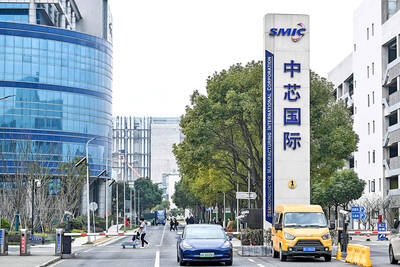The New Taiwan dollar yesterday surged more than 2 percent in another day of volatility for the currency, as exporters’ sales of the greenback tested the central bank’s tolerance for local currency strength.
The NT dollar jumped as much as 2.5 percent to NT$29.160 per US dollar yesterday in the biggest one-day gain since early May, after sliding more than 2 percent on Monday.
The latest move pushed the local currency’s gain this year to 12 percent, making it the best performer in Asia.

Photo: An Rong Xu, Bloomberg
Large foreign inflows and significant US dollar selling by local exporters were seen in the morning session, according to two traders, who asked not to be identified as they were not authorized to speak publicly.
State banks bought the greenback to smooth market liquidity, they said.
The local currency has been buffeted by a series of sharp swings since Friday last week, as the central bank stepped in to check its gains following the US dollar’s decline.
Authorities are eager to prevent a sharp appreciation to ease the pressure on life insurers after a jump in exports amid a trade dispute triggered a wave of repatriation by Taiwanese corporations.
“The Taiwan dollar has been under strong appreciation pressure due to record trade surpluses, equity inflows, and hedging activity by Taiwan life insurance companies,” Australia and New Zealand Banking Group Ltd head of Asia research Khoon Goh (吳昆) wrote in a note.
Since the central bank “strategically allowed” the NT dollar to rally in early May, it has been trying to manage the currency’s strength, he said.
Central bank Governor Yang Chin-long (楊金龍) played down the impact of local currency volatility at the last policy meeting on June 19. The monetary authority said it would continue to promote the “orderly operation of the foreign exchange market” — a line that indicated stability was one of its biggest concerns.
The surge in the local currency came as foreign investors snapped up local shares last month and exporters ramped up sales of the greenback amid concerns the US currency would keep falling. Repatriation of funds from Taiwan’s asset managers also played a role.
While the exact reasons behind the latest moves were unclear, the wild swings in the NT dollar over the past two trading sessions come as domestic firms — including life insurers and exporters — prepare to release their half-year financial reports. The sharp slide which helped the currency close lower on Monday would have helped local firms — many of which have taken a hit from the currency’s rally — to present better financial results.
“Window-dressing type of interventions are seasonal in nature and serve to pause, but not reverse the USD/TWD trend,” Malayan Banking Bhd senior strategist Fiona Lim said in Singapore. “As long as the broader US dollar decline continues, the sell-USD/TWD-on-rally trade could go on.”
The currency pair is expected to swing both ways as the NT dollar gets caught between speculation of central bank intervention and weakness in the greenback, she said.

SEMICONDUCTOR SERVICES: A company executive said that Taiwanese firms must think about how to participate in global supply chains and lift their competitiveness Taiwan Semiconductor Manufacturing Co (TSMC, 台積電) yesterday said it expects to launch its first multifunctional service center in Pingtung County in the middle of 2027, in a bid to foster a resilient high-tech facility construction ecosystem. TSMC broached the idea of creating a center two or three years ago when it started building new manufacturing capacity in the US and Japan, the company said. The center, dubbed an “ecosystem park,” would assist local manufacturing facility construction partners to upgrade their capabilities and secure more deals from other global chipmakers such as Intel Corp, Micron Technology Inc and Infineon Technologies AG, TSMC said. It

NO BREAKTHROUGH? More substantial ‘deliverables,’ such as tariff reductions, would likely be saved for a meeting between Trump and Xi later this year, a trade expert said China launched two probes targeting the US semiconductor sector on Saturday ahead of talks between the two nations in Spain this week on trade, national security and the ownership of social media platform TikTok. China’s Ministry of Commerce announced an anti-dumping investigation into certain analog integrated circuits (ICs) imported from the US. The investigation is to target some commodity interface ICs and gate driver ICs, which are commonly made by US companies such as Texas Instruments Inc and ON Semiconductor Corp. The ministry also announced an anti-discrimination probe into US measures against China’s chip sector. US measures such as export curbs and tariffs

The US on Friday penalized two Chinese firms that acquired US chipmaking equipment for China’s top chipmaker, Semiconductor Manufacturing International Corp (SMIC, 中芯國際), including them among 32 entities that were added to the US Department of Commerce’s restricted trade list, a US government posting showed. Twenty-three of the 32 are in China. GMC Semiconductor Technology (Wuxi) Co (吉姆西半導體科技) and Jicun Semiconductor Technology (Shanghai) Co (吉存半導體科技) were placed on the list, formally known as the Entity List, for acquiring equipment for SMIC Northern Integrated Circuit Manufacturing (Beijing) Corp (中芯北方積體電路) and Semiconductor Manufacturing International (Beijing) Corp (中芯北京), the US Federal Register posting said. The

India’s ban of online money-based games could drive addicts to unregulated apps and offshore platforms that pose new financial and social risks, fantasy-sports gaming experts say. Indian Prime Minister Narendra Modi’s government banned real-money online games late last month, citing financial losses and addiction, leading to a shutdown of many apps offering paid fantasy cricket, rummy and poker games. “Many will move to offshore platforms, because of the addictive nature — they will find alternate means to get that dopamine hit,” said Viren Hemrajani, a Mumbai-based fantasy cricket analyst. “It [also] leads to fraud and scams, because everything is now